A-road Signs
< return to Road Signs This page provides a non-technical guide to the different types of signs used to advise drivers of an upcoming trunk road service area. There is a similar page for Motorway Signs.
Despite a 2018 study finding that the majority of road users think A-road service areas have white-on-green road signs, the rules have in fact been clear that since 2002, all signs related to non-motorway service areas should be in black-on-white, no matter what colour the rest of the direction signs are.
The rules outlined below apply to service areas that meet the required standards. Due to the variable standard of A-road facilities (and the variable competence of highway employees) there are a lot of situations which don't follow these rules to the letter. Individual exceptions can also be authorised.
A 2025 authorisation allows the word "Services" to be replaced by "EV hub", creating a new type of facility with very similar signage. There are currently no examples of this signage being used in full, and it's not clear why the existing "Services" sign couldn't have just been modified to swap the fuel pump symbol for the charging symbol.
Where a service area is positioned at a junction, it's up to the local authority to decide which approaches warrant signage. Generally the idea is that all A-road approaches get signage.
Mainline Signs
Motorway Services
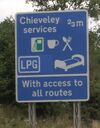
Where a motorway service area is accessed from another road, Diagram 2310.1 should be used on any non-motorway approach, if a sign is needed. This sign is similar to Diagram 2919.1, but it doesn't include a header board or the price of fuel. The sign is the operator's property.
Note that while most service areas that are positioned at a motorway junction are motorway service areas, this isn't automatically the case. Some only qualify for A-road signage, and some don't qualify for anything at all. The rules are also a little vague on how important a side-road should be before it can get full signs (the B1224 has full signage for Wetherby, for example). The 2025 guide suggests this sign is for "non-motorway trunk roads", but that may be as that's all it has authority over.
Even though the standard set of motorway signs were changed in 2012 to include more brand logos, this (and in fact all A-road signs) remain unchanged, and continue to use traditional symbols. This particular sign must include a name for the service area.
This blue sign was introduced in 2002. Before then, large green signs would be used. The new style is similar to the original unofficial A-road services signs.
No other signage is permitted for A-roads approaching motorways, although there are some examples, like on the A3 and the A282.
Primary Sign
For the first time, the 2025 signage guide suggests that A-roads with more than three lanes (which are increasing with number) should have a black-on-white sign placed one mile before the service area, giving the distance, and no other details. This is to allow traffic 60 seconds to move over, and to allow for anybody not seeing a sign while overtaking. While the text is contradictory over whether an arrow should be given, the drawings all show it without one.
The exact distance can be varied depending on the circumstances. Stating the name is optional, but all of the examples in the guide do.
Unlike on motorways, signs are not allowed to refer to a service area any further away than this, probably because the standard of facility can be so variable. But as with every rule on this page, there are examples that break it: the A14 has yellow signs listing all the service areas coming up. A sign on the A34 lists "Services" on the route confirmatory signs, as if it were a town.
Approach Sign
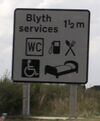
Much like the approach sign on the motorway, Diagram 2313.1 is placed half a mile before a service area, or more if that would interfere with other signs. There are two completely different signs which can be used here:
- Diagram 2313.3 includes a plate saying either 'not 24 hours' or 'fuel only 24 hours'. Precise opening hours should never be given.
- Diagram 2313.5 could be used for services which are open to lorries only (includes the HGV symbol and "lorries only") - but this is redundant.
- A variant of Diagram 2313.5 should be used for services which ban lorries, with a red bar through the symbol and "lorries only" omitted (this can be seen below).
All of these signs allow for the geographical name of the services to be included - it's not mandatory, but it is becoming increasingly common for each service area to be named, and all the example drawings show this. The symbols on the sign are varied depending on the facilities, and can include: WC, petrol pump, either a cup or a fork and spoon, LPG, tourist information and a bed. They no longer need to include the disabled symbol.
Other than those mentioned above, there is no blanket allowance for any additional messages, such as "last services before motorway" or "with access to all routes", although these are common.
These signs are the responsibility of the operator. The 2025 document has renamed this sign to "secondary sign".
Direction Sign
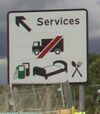
Where the service area is at a junction, there is a similar range of signs to be included immediately before the diverge. The signs used to provide the same information but include an arrow pointing in the correct direction (which is almost always down a slip road). If the previous sign was a Diagram 2313.1 then Diagram 2313.2 should be used here, 2313.4 should come after 2313.3 and 2313.6 should come after 2313.5 - the latter is the example used here.
The bed and lorry symbols, including any red bars, must be reversed if the arrow is pointing towards the right.
The purpose of this sign is to assure drivers that they really do want the next exit, even though it goes somewhere else. These signs are also the responsibility of the operator.
The 2025 update, which renamed this sign to "final direction sign", bizarrely says that facility symbols must only be used if the service area is at a junction. All of the example drawings, including those for a junction, show it with no symbols at all, despite the text saying that the symbols must be the same on both signs. It also says that if the legend "Services" can be incorporated into the existing direction signs, which it should be, then this sign can be skipped altogether.
Supporting Signage
Exit Sign
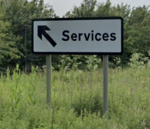
Diagram 2314.2 (formerly 2315.1) allows an arrow pointing to the top-left, just like similar signs usually found at a junction. There are few examples of this in action, perhaps because of confusion caused by it not being allowed on motorways. The text "Services" can also be added to any existing exit sign, but it must never be named.
Unlike the motorway equivalent, these signs are the responsibility of the operator. The 2025 update calls this sign the "confirmatory direction sign".
Continuity Signing
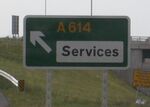
Where service areas aren't immediately accessible from the road, the legend 'Services' on a white patch should be used to direct traffic to the right place. This includes the sign at the exit from the road, which is the example on the right.
The 'Services' legend must always be in black-on-white, unless the service area is classed as a motorway service area, in which case it must be white-on-blue. In both cases, a full name may be used, but rarely is. If directions are painted on the road, they must say "SERV" (never "S'VCS").
Where a junction provides access to two different service areas, or one service area that has two entrances, the regulations don't offer any advice as to how the two can be differentiated. Normally, motorists will just see two different directions for "Services", as is the case at Markham Moor, Willowtree and Picket Post. Ferrymuir is now called "alternative services" to avoid confusion.
The word "Services" on a black-and-white sign with an arrow can also be used to give directions to what the rules call "a generic description of a facility". This is generally done on non-trunk roads, so is explained further down.
Other Signs
Local Facilities
Traders in by-passed communities often ask for signs to direct traffic back onto the old road. Since 1994, they or the local authority can fund a Diagram 2308.1 sign which points to "local facilities" and includes the symbols WC, petrol pump, cup, spoon and fork, bed and tourist information as required. For more specific facilities, Diagram 2328 should be used, which is in white-on-brown tourist colours.
If the direction to these facilities is not obvious, Diagram 2309.1 points to them and includes the distance.
Diagram 2025 looks like a normal junction sign, but has an extra road leaving the destination and rejoining the main carriageway. This can also be used to show a village which is alongside the main road and allows you to easily drive through it.
Truckstops
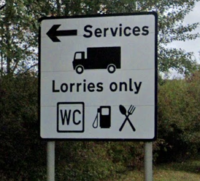
The regulations note three different types of truckstop, and treat them all completely differently.
"Truckstops signed from the SRN" uses white-on-black signs, and instead of saying "services - lorries only", they say "truckstop". There was some confusion about whether this could be used on A-roads, but since 2016 it has been clear that it can, and the 2025 guide suggests this is the only sign suitable for an A-road truckstop.
"Trunk Road Truckstops (fully qualifying)" used black-on-white signs, very similar to the 'Approach Sign' given above but with the words "lorries only" and a HGV symbol added. It still used the word "Services". It no longer appears in the signage guide, despite still being permitted.
A quick look at truckstops around the UK shows that highway authorities didn't seem to know what the difference is either. Tayside (A90) uses white 'services' signs, Holyhead (A55) used black 'services' signs, Rothwell (A14) mostly uses white 'truckstop' signs and Red Lion (A4500) uses black 'truckstop' signs. Those from before 2008, before truckstops were officially acknowledged, tended to improvise with green signs, or they'd fall under the line below. The Red Lion example is the only one which is compliant with the 2025 guide.
The third category is "Trunk Road Truckstops (not meeting criteria)", and these are selected on a case-by-case basis. They do not use words, but just show the parking symbol, along with other facilities such as toilets and a pay phone.
These signs are all paid for by the operator.
Lay-bys
While lay-bys aren't service areas as such, it's worth noting them. These are built and run by England's national highway authority and the 1 mile sign should either consists of Diagram 2501 (the blue P sign) or, for larger facilities, Diagram 2502, which is black-on-white and can include the symbols for parking, toilets, pay phone, tourist information and HGV spaces. The entrance should have a Diagram 801 sign (the standard parking sign).
Very large lay-bys are classed as "picnic areas" and treated as a tourist attraction, similar to a scenic viewpoint. For this reason, lay-bys that need more than the symbols given above (like those with picnic tables, toilets or refreshments) should use white-on-brown signs. This can cover a wide range of roadside car parks, none of which qualify as service areas.
Non-Trunk Roads
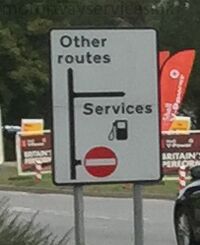
The rules described here are created by what's now called National Highways, who manage trunk roads in England. Other authorities are expected to follow this policy if they want to signpost a service area, but the rules weren't created with local roads in mind and things quickly become messy.
A common grey area is what happens when responsibility for a road passes from National Highways to a local authority. The evidence from Redwings (where the A1 became a B-road) and the A45 (where the road's status was downgraded) is that the signs are often left up and appear to be forgotten about.
In cases where a local authority road approaches a National Highways road at a junction which has a full service area, it won't normally have signs, simply because nobody will agree on who should pay for them. If National Highways are changing the junction and paying for new signs anyway, or if the developer is building a new service area and paying for new signs anyway, then signs may be placed on the local road too, as happened at Cherwell Valley.
Those two points apply to service areas with full advance signage, of the type described throughout this page. There is one more circumstance which really complicates things: it's what the rule book calls "a generic description of a facility".
You aren't allowed to use brand names on road signs, so if you have a situation where you need to tell people which lane goes to the McDonald's (for example at Coastways), you have to think of a more generic word to use. "Services" is often used as a substitute for giving brand names, and this is acceptable, even if the place doesn't actually qualify as an official service area as per the national policies.
That final complication almost always applies only to local roads, as these days the national highway authority will usually insist on full signage being provided if you're going to be building near a major road. However there are still some exceptions, for example on the A50 near Uttoxeter, there are two exits in quick succession and one of them is described as "Services" to prevent people mixing them up.
History
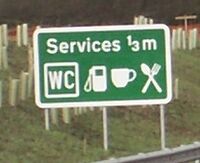
Until the introduction of the green sign in 1982, there were no permitted signs for any non-motorway services. Any "Services" sign had to refer to a 24 hour facility, including the flag signs that are today used on local routes.
The Department for Transport had started to use standard motorway signs for some A-road services, which attracted criticism from motorway operators who reckoned their reputation was being dragged down by unscrupulous roadside garages. Tourist attractions were signed in white-on-blue between 1964 and 1994, and sometimes these this style was used to acknowledge roadside facilities.
Green Approach, Direction, Exit and Continuity signs were permitted until 2002. After this, they were supposed to be in black-on-white; an amnesty on existing signs expired in 2015. Despite this, many examples still exist, and were still being put up long after they should have stopped. In fact, the Metropolitan Borough of Solihull installed brand new green 'services' signs (with the modern charging point symbol) on the A45 in 2025, 23 years after they were told to stop doing this.
The policy on A-road signs was reviewed in 2008, and issues with truckstop signs and mileage signs have been tinkered with since then.